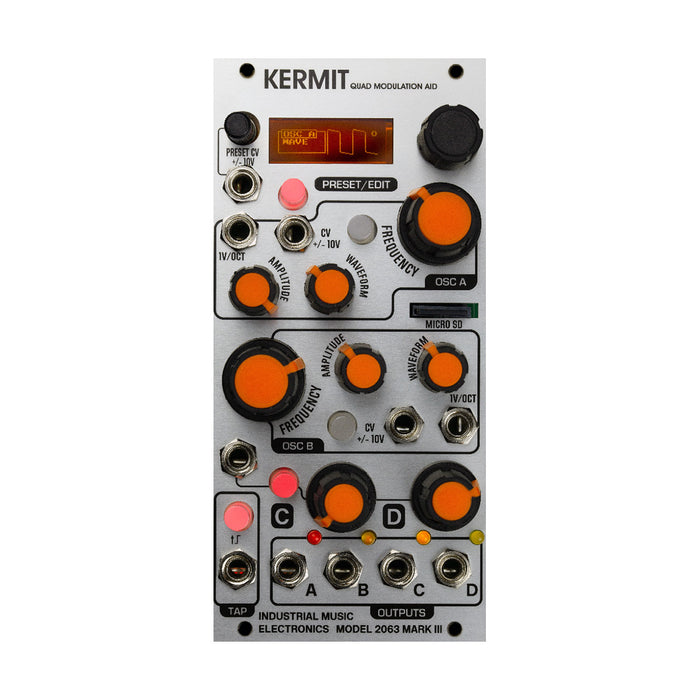
Industrial Music Electronics Kermit mkIII
Format: Eurorack
Width: 12HP
Depth: mm
Current: 135mA@+12V, 50mA@-12V
Manual pdf (English)

Format: Eurorack
Width: 12HP
Depth: mm
Current: 135mA@+12V, 50mA@-12V
Manual pdf (English)
Kermit is a four-channel, tempo-synchronous, wavy-table obsator that is optimized for LFOs.A C or D crater is a single knob, but a botancomo operation enables you to set up a parameter similar to A or B independent of the C or D.Each channel acts as either an LFO, an orator, an envelope, a random, or a sample & hold.The Frequency, Waveform, Amplitude parameter has a different function type for each operation type, but it is very similar to the function type.Each parameter can be assigned to the end of the modulation of the external CV input.And also, as a characteristic of Kermit, we don't have to patching each otherChannel-to-channel modularablefor theA compact plane is packed with the potential for maximum patches.
Signals are output by default with a 16-bit signal, allowing for accurate waveforms on slow LFOs.The pitch stability of the pitch is less stable and low, and the lower frequencies work as well.Sound quality is a sound with a cool texture, which is digital, and so on.accessible via a channel menuCharacterSetup allows you to make the waveform more rophi.Each of the rophine waveforms has a unique character, with a number of 32 samples at 8 bits and closer to the texture of the vintage Konami SCC chip.from the Micro SD carda unique wavyit can be loaded.Just like Piston Honda Mk3, the weave table to be loaded is a free one developed by Synthesis Technology.WaveditIt can be created by the software.In the top folder of the micro SD card formatted with FAT, put a wave table file under the name "1.wav" and load it from "Load Waves from SD" of the global menu.The original wave table will be erased, but the IMEwebsitecan be downloaded from the download.
Each operation type has a synchronization of the master tempo to the split clock.Master tempo?TAPSet by using Tap tempo or clock input from a section.
All the aissigns and the non-knob parameter settingsPresetis stored in the system, and the CV switches between multiple presetsMorphingin the following table.Preset morphing is possible with all Mk3 series of Mk3 series modules, but Kermit will demonstrate its power, especially its power.
In CH C/D, one knob per channel sets a parameter equivalent to CH A/B, and then presses the button and rotate the knob.The following table will be the corresponding button for each parameter:For example, to set the Wave of a CH D, hold the CH B button and the CH C/D common button, and then turn the knob of CH D to set.

You set the sign of the CV input for each channel as shown in the following table:For example, if you want to modulate Waveform in the CV input of Channel A, press the encoder to turn the Waveform knob of CH A.CH C/D has a common CV input, and has a small number of knobs, so the way of sign C/D is different.For example, if you want to modulate the size of a CH D with a C/D common CV input, then press the encoder and the CH A button, then turn the knob of CH D.

The modulation aspect between each channel is set as shown in the following table.For example, if you want to modulate the Frequency of CH B with CH D, press the C/D common button and the encoder, then turn the Freq knob on CH B.If you want to modulate the Waveform of CH D with CH C, press the C/D common button, the encoder, and the TAP button, and then turn the knob on the CH D. 
Press the buttons in CH A, B, C/D while pressing the encoderChannel menuwill be displayed on the display.CH C/D is common to the menu screen and CH D is displayed after CH.In addition to the choice of motion type mode, you can clear the voltage range (12Vpp :LFO or random, 0-6V: for envelop, 1Vpp: video synthesizer), clear sign, or Character selection above.
holding the encoder, and pressing the button on the side of the display,Global Preset Menuwill be displayed.You can save the preset, call it, clear other presets of the preset, or load the wave tables from the microSD above.